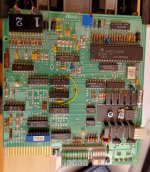I am looking for a service manual for a IBM PC XT 5160 5.25" drive. However, it is NOT a Tandon drive.
It has a part # 0384-002 and 6181147. There are pictures of it in this thread
The problem is that for a while it was "dying" and would only start working when the computer was on for 10 or 15 minutes, not responding, or only spinning and not reading correctly, until it had been on for a certain amount of time. I put it away in storage for two years, and now it appears to be completely dead, not even spinning or attempting to read.
I know that frequently the tantalum capacitors are to be suspected for old IBM equipment, and that they generally fail short. There are numerous 1/4" resistor-sized yellow components on the board, and tantalums are usually yellow, however I can not identify a band on them to indicate polarity, which tantalums generally have. I don't feel any of the components getting hot, however, and if a capacitor did fail short, I would expect that the power supply would trip if the current exceeded safe limits.
There are also two polarized caps near the 4-pin power connector, which could be tantalums, but they are blue-black in color. There is a small toroid inductor next to them, perhaps to filter noise from the power?
There is a Texas Instruments 40-pin socketed chip DCU8423, dated 1981. I have no idea what this is, perhaps a microcontroller? SN75478 driver ICs perhaps for the drive head stepper motor?
Before I go on an extensive teardown, are there any obvious things to look at, or common problems? Often a service manual will indicate those, but I can only find a service manual for the Tandon drive, not the drive I have. For example, there is a 2N6667 Darlington power transistor which is probably to turn the spindle motor on and off.
Thanks for any guidance!
It has a part # 0384-002 and 6181147. There are pictures of it in this thread
The problem is that for a while it was "dying" and would only start working when the computer was on for 10 or 15 minutes, not responding, or only spinning and not reading correctly, until it had been on for a certain amount of time. I put it away in storage for two years, and now it appears to be completely dead, not even spinning or attempting to read.
I know that frequently the tantalum capacitors are to be suspected for old IBM equipment, and that they generally fail short. There are numerous 1/4" resistor-sized yellow components on the board, and tantalums are usually yellow, however I can not identify a band on them to indicate polarity, which tantalums generally have. I don't feel any of the components getting hot, however, and if a capacitor did fail short, I would expect that the power supply would trip if the current exceeded safe limits.
There are also two polarized caps near the 4-pin power connector, which could be tantalums, but they are blue-black in color. There is a small toroid inductor next to them, perhaps to filter noise from the power?
There is a Texas Instruments 40-pin socketed chip DCU8423, dated 1981. I have no idea what this is, perhaps a microcontroller? SN75478 driver ICs perhaps for the drive head stepper motor?
Before I go on an extensive teardown, are there any obvious things to look at, or common problems? Often a service manual will indicate those, but I can only find a service manual for the Tandon drive, not the drive I have. For example, there is a 2N6667 Darlington power transistor which is probably to turn the spindle motor on and off.
Thanks for any guidance!

